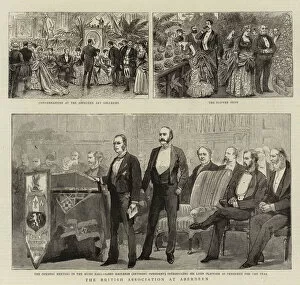Lord Rayleigh Collection
Lord Rayleigh, also known as John William Strutt, 3rd Baron Rayleigh, was a prominent British scientist in the late 19th and early 20th centuries
All Professionally Made to Order for Quick Shipping
Lord Rayleigh, also known as John William Strutt, 3rd Baron Rayleigh, was a prominent British scientist in the late 19th and early 20th centuries. His contributions to various fields of science earned him recognition and accolades throughout his career. Born on November 12, 1842, Lord Rayleigh's scientific journey began at a young age. He became a member of The Royal Society, an esteemed scientific organization that promotes excellence in science. This engraving depicts Lord Rayleigh among his fellow members of The Royal Society, showcasing his involvement in the scientific community. Lord Rayleigh's expertise extended beyond theoretical research; he actively participated in scientific conferences and events. In this engraving titled "With the British Association in Canada, " we see Lord Rayleigh engaging with other scientists from around the world during one such event. His dedication to advancing scientific knowledge led him to establish the Davy-Faraday Research Laboratory adjoining the Royal Institution on Albemarle Street. Here we witness The Prince of Wales opening this prestigious laboratory alongside Lord Rayleigh himself. Throughout his career, Lord Rayleigh pursued groundbreaking research projects that pushed boundaries and expanded our understanding of nature. This lithograph titled "The search for unknown elements" symbolizes his relentless quest for discovery and innovation. In addition to his own work, Lord Rayleigh played an active role within various institutions dedicated to promoting science education and collaboration. One such institution is The Centenary of the Royal Institution depicted here through an engraving capturing its grandeur celebration. Lord Rayleigh's influence reached far beyond England's borders as he engaged with international scientific communities. This engraving showcases The British Association at Aberdeen where he undoubtedly shared insights and exchanged ideas with fellow scientists from different backgrounds. Not only did he excel scientifically but also politically as seen in this engraving titled "Movers and Seconders of the Address in Parliament. " It highlights how respected he was amongst both his scientific peers and the political elite.












